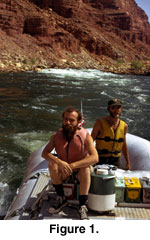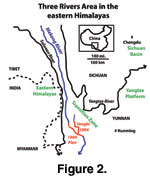INTRODUCTION
 I first met Will Downs on a Grand Canyon trip in
1974. I was working as a river ranger for Grand Canyon National Park, and Ben
Foster and Will came along on one of my patrol trips (Figure 1) to retrieve some
late Precambrian fossils they had left on a recent hiking trip. At the time,
Will was learning Mandarin Chinese at Northern Arizona University in Flagstaff
and was working at the Museum of Northern Arizona as a preparator in the Geology
Department.
I first met Will Downs on a Grand Canyon trip in
1974. I was working as a river ranger for Grand Canyon National Park, and Ben
Foster and Will came along on one of my patrol trips (Figure 1) to retrieve some
late Precambrian fossils they had left on a recent hiking trip. At the time,
Will was learning Mandarin Chinese at Northern Arizona University in Flagstaff
and was working at the Museum of Northern Arizona as a preparator in the Geology
Department.
Will and I became good friends on the patrol trip.
He was instrumental in convincing me to go to Northern Arizona University in
Flagstaff in 1975 to study geology. Over the next few years, my wife Cindy Appel
(a USGS hydrologist) and I taught Will to row a raft on several whitewater
rivers in Utah and Arizona. From the late 1970s until he died, Will was one of
our favorite oarsmen on numerous trips on the San Juan, Green, and Colorado
rivers. He was also an oarsman on a 1988 trip on the Rio Grande River near Taos,
New Mexico, with Bruce Babbitt, then Governor of Arizona, who was helping us to
raise funds for an expedition on the Mekong River in Yunnan, China. Cindy and I
invited Will to row on all four of our Grand Canyon private trips (1982, 1990,
1997, and 2001).
Will became a surrogate uncle to our children,
Travis and Carmen, and helped teach them to row. Inspired in part by Will,
Travis is currently living in China, studying geology, and learning Mandarin.
Carmen is currently a science geek in high school and hopes to travel to China
to learn Mandarin when she attends college.
I made a video of Will’s runs in major rapids on
our Grand Canyon trips. It is available for free in return for contributions to
Will’s Flip Side
website. This website contains pictures of Will and
his friends and stories by and about Will on his paleontological adventures in
China, Pakistan, Greenland, Africa, and Arizona and his rafting adventures in
China and the USA, plus links to his paleontological publications and his famous
“goodbye” missives. The website, the Grand Canyon video, and this article
resulted from discussions with Will and many of his friends during our last
visit with him in Flagstaff a few weeks before he died.
By the mid 1980s, I was working on an MS in
geology at the University of Utah. Mike Connelly (another University of Utah
geology graduate student who had extensive whitewater experience), Will and I
decided that we wanted to conduct geological reconnaissance expeditions on
rivers in western China. Will had learned Chinese in the mid 1970s, had been
translating Chinese paleontological reports into English for several years
(translations
downloadable as PDF files), and was embarking on paleontological field work in China in the
next few years. His advice was invaluable, especially his frequent reminder that
there are three rules for doing business in China: patience, patience, and
patience. The Chinese have a vastly different sense of time than we do.
 During the 1980s, a team of geologists, writers,
and photographers developed plans for raft trips devoted to geological
reconnaissance, especially to the tectonics of mountain building. Several of us,
including Will and me, recognized that rocks along the upper Mekong drainage
were relevant to competing models of Himalayan tectonics (Figure 2). We
developed a
research proposal to investigate this region.
During the 1980s, a team of geologists, writers,
and photographers developed plans for raft trips devoted to geological
reconnaissance, especially to the tectonics of mountain building. Several of us,
including Will and me, recognized that rocks along the upper Mekong drainage
were relevant to competing models of Himalayan tectonics (Figure 2). We
developed a
research proposal to investigate this region.
After failing to get the support of the National
Geographic Society and the National Science Foundation, we contacted Bruce
Babbitt through mutual friends in Flagstaff, Arizona, to seek his help in
getting corporate support. Before he was elected governor of Arizona, Babbitt
was a geologist and river runner with an interest in the Mekong drainage. In
April 1989, with his help we convinced the Coca-Cola Company to fund a 25-person
research expedition. We were planning to conduct the expedition at low flows
that November. However, the Tienanmen Square Event occurred in June, so
Coca-Cola decided to hold off on funding, plus no one wanted to go to China
after that event. If you don’t recall, the Chinese army drove tanks toward Chinese
citizens who were peacefully demonstrating for greater freedom in front of the
People’s Hall.

 I first met Will Downs on a Grand Canyon trip in
1974. I was working as a river ranger for Grand Canyon National Park, and Ben
Foster and Will came along on one of my patrol trips (Figure 1) to retrieve some
late Precambrian fossils they had left on a recent hiking trip. At the time,
Will was learning Mandarin Chinese at Northern Arizona University in Flagstaff
and was working at the Museum of Northern Arizona as a preparator in the Geology
Department.
I first met Will Downs on a Grand Canyon trip in
1974. I was working as a river ranger for Grand Canyon National Park, and Ben
Foster and Will came along on one of my patrol trips (Figure 1) to retrieve some
late Precambrian fossils they had left on a recent hiking trip. At the time,
Will was learning Mandarin Chinese at Northern Arizona University in Flagstaff
and was working at the Museum of Northern Arizona as a preparator in the Geology
Department. 